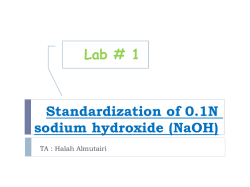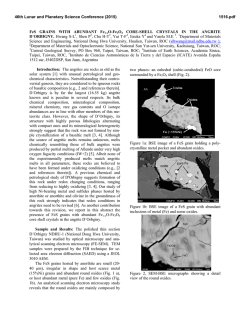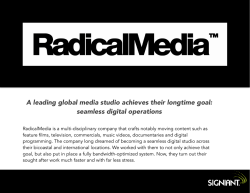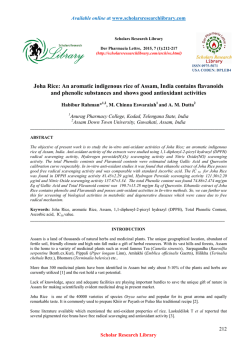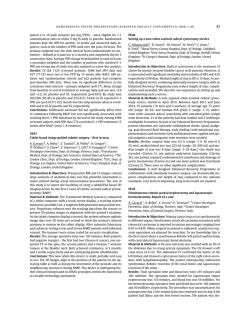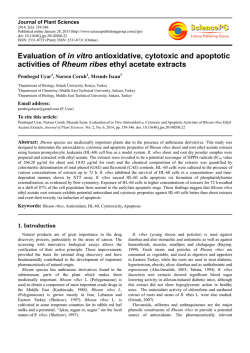
Structure identification and antioxidant activity of a noveltriple helical
Available online www.jocpr.com Journal of Chemical and Pharmaceutical Research, 2015, 7(1):678-684 Research Article ISSN : 0975-7384 CODEN(USA) : JCPRC5 Structure identification and antioxidant activity of a novel triple helical polysaccharide isolated from Dictyophora indusiata Jun-Hui Wang*, Ya-Kun Zhang, Yu-Fei Yao, Yong Liu, Jin-Long Xu and Han-Ju Sun School of Biotechnology and Food Engineering, Hefei University of Technology, Hefei, People’s Republic of China _____________________________________________________________________________________________ ABSTRACT In this paper, an alkali-soluble polysaccharide DIPs-3 was extracted with 5% NaOH/0.05% NaBH4 from the fruiting of Dictyophora indusiata. The structure of DIPs-3 was investigated by a combination of chemical and instrumental analysis. The monosaccharide composition analysis showed that DIPs-3 consisted of glucose only. Structural analysis revealed that DIPs-3 had a backbone of (1→6)-linked β-D-Glcp with substitutes at O-4 of Glcp residues. The branches were composed of terminal β-D-Glcp. Congo red analysis and dynamic rheology experiments indicated that DIPs-3 was a triple helical polysaccharide. The results of antioxidant activities showed that DIPs-3 exhibited high DPPH radical, ABTS radical and hydroxyl radical scavenging activities. It was suggested that DIPs-3 could be used as a potential natural antioxidant in food industry. Keywords: Dictyophora indusiata; Polysaccharide; Structure; Antioxidant activity _____________________________________________________________________________________________ INTRODUCTION Polysaccharide is long carbohydrate molecule, which is composed of more than 10 monosaccharides through glycosidic keys and denoted by (C6H10O5)n as general formula. The polysaccharide is also one of three biomacromolecules in vivo and the most abundant materials in nature, widely existing in plants, cell membrane of animals, cytoderm of microorganisms (fungi and bacteria), lichens and seaweed [1-6]. Meanwhile, polysaccharide has a variety of biological functions, such as energy storage, structure support, defense and antigenic determinant [1, 7]. Owing to their roles as texture modifiers, gelling agents and packaging films, polysaccharide has been applied in the fields like food industry, cosmetics, textiles and biomedicine. [1-4]. Dictyophora indusiata is a precious edible and medicinal mushroom [8, 9]. It is called “Snow skirt fairy” and “the queen of fungi” in China. According to its health benefits, a series of studies has been carried out on Dictyophora indusiata [10-12]. It is found the polysaccharide is the main active components in Dictyophora indusiata, which possessed antioxidant activities, immunological activities,antitumor activities and antifatigue activities[10-12]. In this study, a novel triple helical polysaccharide DIPs-3 was extracted with 5% NaOH/0.05% NaBH4 from the fruiting body of Dictyophora indusiata. Further, to make DIPs-3 better application in the food industry, the structural characteristics and antioxidant activities of DIPs-3 were investigated. EXPERIMENTAL SECTION 2.1. Extraction and purification The dry fruiting of D. indusiata was purchased from Qingchuan county, Sichuan province of China. Voucher specimen was deposited in the herbarium of the School of Biotechnology and Food Engineering, Hefei University of Technology (No: DI0001). After crushed into powder, the dry fruiting body of D. indusiata was extracted with boiling water. The residues were extracted with 5% NaOH/ 0.05% NaBH4 at 25 °C for 2 h twice. Then, the supernatant was neutralized with 36% acetic acid to remove α-D-glucan [13] and subjected to the Sevag method to 678 Jun-Hui Wang et al J. Chem. Pharm. Res., 2015, 7(1):678-684 ______________________________________________________________________________ remove free proteins [14]. Acetone was added to the concentrated supernatant. The precipitates was dissolved in the distilled water, dialyzed and lyophilized to obtain colorless polysaccharide (DIPs-3). The homogeneity and molecular weight of DIPs-3 were determined by HPLC system (Waters Company) with refractive index detector and a linked column of UltrahydrogelTM linear column (7.8×300 mm, Part No. WAT011545) and UltrahydrogelTM500 column (7.8×300 mm, Part No. WAT11530). The operation condition was setting as follows: setting 4, column temperature rising to 34 °C at slowly rate of 0.5 °C/min and triple distilled water as mobile phase at the flow rate 0.5 mL/min. Standard dextrans (T-1000, T-500, T-100, T-50 and T-20, Pharmacia) were used to draw standard curve. 2.2. FT-IR analysis The FT-IR spectrum of DIPs-3 was carried out on a PerkinElmer 599B FTIR spectrometer and scanned in the wave-number range 400~ 4000 cm-1. 2.3. Monosaccharide composition analysis 5 mg sample was hydrolyzed at 120°C with 4 mL 2 mol/L CF3COOH (TFA) in the sealed tube. The hydrolyzed products were reduced with 20 mg of NaBH4 and acetylated with 3 mL of acetic anhydride (containing 3 mL of pyridine). The alditol acetates were analyzed by gas chromatography (GC). The operation conditions were reported in the previous study [15]. 2.4. Methylation analysis Methylation was carried out according to the modified Ciucanu method as described by Needs & Selvendran [16]. The methylated products was hydrolyzed with 2 M TFA for 3 h at 120°C and converted into partially methylated aditol acetates. The alditol acetates were analyzed by GC–MS according to the reference15. 2.5. NMR analysis DIPs-3 was dried using P2O5 for several days before experiments. The dried DIPs-3 sample was dissolved in DMSO-d6. 1H-NMR and 13C-NMR were measured by Bruker-400 NMR spectrometer with a dual frequency probe in the FT mode at 27 °C. 2.6. Congo red analysis Congo red analysis was performed according to the method of Yang et al [17]. In brief, DIPs-3 (8 mg) was dissolved in 4.0 mL distilled water and 2.0 mL 80 µmol/L of Congo red solution was prepared. Then, 4.0 mL Polysaccharide solution was mixed with 2.0 mL Congo red solution, a certain amount of NaOH solution (1.0 g/L) and distilled water to reach 8 mL volume. The concentration of NaOH stepwise reached a gradient concentration 0.00, 0.05, 0.10, 0.15, 0.20, 0.25, 0.30, 0.35, 0.40, 0.45 and 0.50 mol/L, respectively. The absorbance was detected by UV-Vis spectrometer in the range 800-200 nm. 2.7. Dynamic temperature sweep The DIPs-3 was dissolved in distilled water with the final concentration of 1.0×10-3 g/mL. After incubation at room temperature for 24 h, the viscosity of the samples was determined using stress controlled rheometer (TA, USA) with cone plate (40mm in diameter, 2°). Temperature sweeps (0 to 20°C at 1Hz, 1% strain) were applied to study the temperature dependence of G’’. 2.8. Dynamic frequency sweep of DIPs-3/NaOH DIPs-3 (14 mg) was dissolved with 1.5 mL deionized water. Then, 0.5 mL sodium hydroxide solutions with different concentration were added to the mixture to reach a gradient concentration 0.00 0.04, 0.05, 0.06, 0.07 and 0.08 mol/L, respectively. After equilibration at room temperature for 24h, the frequency sweeps (10-1~102 rad/s, 20 °C) were applied to study the frequency dependence of G´ and G". 2.9. Evaluation on the antioxidant activities 1, 1-diphenyl-2-picrylhydrazyl (DPPH) radical scavenging activity: The scavenging activity of DPPH radicals was measured according to the reported method [18]. DPPH solutions (2 mL) in ethanol (w/v 0.004%) and 0.5 mL tested samples with different concentrations were mixed in the tube. The mixture was incubated for 30 min in the dark at 25 °C, and the decrease of absorbance at 517 nm was measured against ethanol using a Vis spectrophotometer. Vc was used as the positive control. The 2, 2-azino-bis (3-ethylbenzthiazoline sulphonate) (ABTS) free-radical scavenging activity: The radicals scavenging activity of the polysaccharides against radical cation (ABTS+) were measured using the methods of Cheng et al [19]. ABTS+ was produced by reacting 7 mmol/L ABTS+ solution with 2.45 mmol/L potassium 679 Jun-Hui Wang et al J. Chem. Pharm. Res., 2015, 7(1):678-684 ______________________________________________________________________________ persulphate at room temperature for 16 h in the dark. The ABTS+ solution was diluted with ethanol to an absorbance of 0.70 ± 0.02 at 734 nm. Each sample (0.2 mL) with various concentrations (0.01–2.0 mg/mL) were added to 2 mL ABTS+ solution and mixed vigorously. After reaction at room temperature for 6 min, the absorbance at 734 nm was measured. Ascorbic acid (Vc) was used as positive controls. Hydroxyl radical scavenging activity: Hydroxyl radical scavenging activity was assayed using salicylic method [20]. Hydroxyl radical was formed by Fenton reaction. Different polysaccharide solutions (0.2mL) at various concentrations were mixed with 1 mL 2 mM FeSO4,0.4 mL 2 mM sodium salicylic and 1 mL 1 mM H2O2. Then the mixture was kept in water bath at 37℃ for 1 h. The absorbance of resulting solution was measured at 510 nm. Ascorbic acid (Vc) was used as positive controls. Fe2+ chelating activity assay: Fe2+ chelating activity was tested refer to the method reported previously [21]. Firstly, FeCl2 solution (0.05 mL, 2 mM) and ferrozine solution (0.2 mL, 5 mM) was prepared. Then, polysaccharide solution, FeCl2 solution, ferrozine solution and distilled water were mixed to get different concentration solution. After the mixture was incubated at room temperature for 10 min, the absorbance at 562 nm was detected. Distilled water was served as control and ethylenediaminetetraacetic acid disodium salt (EDTA-2Na) was used as positive control. The experimental data were subjected to a one-way analysis of variance for a completely random design to determine the least significant difference at the level of 0.05. The data values were expressed as mean ± SD (n ≥ 3). RESULTS AND DISCUSSION 3.1. Purification, composition and structure analysis of DIPs-3 Fig.1: HPGPC (A), FT-IR (B), GC(C) and 13C-NMR (D) spectra of DIPs-3 The water extraction residues from the fruiting body of D. indusiata were further extracted with 5%NaOH/0.05% NaBH4. The extracted liquid was neutralized, deproteinized and dialyzed to give the crude polysaccharide fraction. The crude polysaccharide fraction was purified through cold acetone to obtain colorless polysaccharide DIPs-3. DIPs-3 was a homogeneous polysaccharide fraction with average molar weight 4.9 × 105 determined by HPGPC (Fig.1A). DIPs-3 was free of uronic acid as revealed by m-hydroxydiphenyl colorimetric method [22] and the absence of absorptions at 1720 cm-1 in the FT-IR spectrum (Fig.1B). Moreover, the band at 890 cm-1 in Fig.1B was 680 Jun-Hui Wang et al J. Chem. Pharm. Res., 2015, 7(1):678-684 ______________________________________________________________________________ the typical characteristic peaks for β-D-glucose [23]. GC analysis (Fig.1C) indicated that DIPs-3 was composed of glucose only. Methylation analysis revealed the presence of (1→6)-linked β-D-Glcp, (1→4, 6)-linked β-D-Glcp and terminal β-D-Glcp in the molar ratios of 4.0: 1.1: 1.0 in DIPs-3, indicating DIPs-3 was a branched polysaccharide. The total molar recovery of nonreducing terminal residues was approximately equal to that of branched residues, suggesting all sugar residues appeared to have been completely methylated. NMR experiments (Fig.1D) were performed to further validate the DIPs-3 structure. Assignments of signals and identification of sugar residues were done by comparison of the chemical shifts with published data on similarity substituted sugar residues [24, 25]. In the 13C NMR spectrum of DIPs-3 (Fig. 1D), signals at δ 102.9 and 101.9 were attributed to C-1 of β-D-Glcp. The signals at δ 69.9 and 68.6 were assigned to C-6 of (1→6)-linked β-D-Glcp and (1→4, 6)-linked β-D-Glcp, respectively. The signal C-4 of (1→4, 6)-linked β-D-Glcp was identified at δ 76.7. Based on the above results and published reference [10], it was suggested that DIPs-3 had a backbone of (1→6)-linked β-D-Glcp with terminal β-D-linked Glcp side chains substituted at O-4 of (1→6)-linked β-D-Glcp residues. 3.2. Chain conformation analysis of DIPs-3 Fig.2: Changes in the absorption maximum of the Congo red–polysaccharide complex at various concentrations of NaOH (A). Storage modulus (G´) determined by dynamic temperatures sweep measurement at 1 rad/s for DIPs-3 (B) Fig.2A showed that the maximum absorption wavelength (λmax) of Congo red in the presence of DIPs-3 at various concentrations of sodium hydroxide solution. The results revealed that λmax increased initially and then reduced gradually to reach constant with the increasing concentration of sodium hydroxide solution. λmax of Congo red was largely red-shifted in the presence of DIPs-3, confirming that DIPs-3 had triple-helix conformation in low concentrate of sodium hydroxide solution. However the triple helical structure was destroyed in high concentrate of sodium hydroxide solution [17, 26]. Fig.2B showed the storage modulus determined by dynamic temperatures sweep measurement at 1 rad/s for DIPs-3 in water. As shown in Fig. 2B, the storage modulus sharply decreased in the narrow temperature region from 4 °C to 7 °C. This was due to the order-disorder transition referring to the literature [27]. Fig.3 showed storage modulus G´ (solid symbols) and loss modulus G" (open symbols) vs frequency ω for DIPs-3 solutions (7×10-3 g/mL) in 0.00 (Fig.3A), 0.04 (Fig.3B), 0.05 (Fig.3C) 0.06 (Fig.3D), 0.07 (Fig.3E) and 0.08 (Fig.3F) mol/L NaOH at 20 °C, respectively. 681 Jun-Hui Wang et al J. Chem. Pharm. Res., 2015, 7(1):678-684 ______________________________________________________________________________ Fig.3: Storage modulus G´ (solid symbols) and loss modulus G" (open symbols) vs frequency ω for DIPs-3 solutions (7×10-3 g/mL) in 0.00, 0.04, 0.05,0.06, 0.07 and 0.08 mol/L NaOH at 20°C, respectively As shown in Fig.3, at low cNaOH (≤ 0.05 mol/L), the increased NaOH concentration could promote the gel formation. While at high cNaOH (> 0.05 mol/L), the increased NaOH concentration would not promote the gel formation. When NaOH concentration was 0.05~0.06 mol/L, DIPs-3 solution was changed from entanglement network to weak gels. The results revealed that the triple helix structure gradually dissociated into single helix when the NaOH concentration increased from 0 to 0.05 mol/L [28]. Further increased NaOH concentration (> 0.05 mol/L), DIPs-3 transited from single helix to random coils [28]. Thus, DIPs-3 had triple helical chain conformation based on the Congo red and dynamic rheology analysis. 3.3. Antioxidant activity analysis of DIPs-3 Antioxidant activities of DIPs-3 in vitro, including DPPH radical scavenging activity, ABTS radical scavenging activity, hydroxyl radical scavenging activity and Fe2+ chelating activity were tested. The results were shown in Fig.4. DIPs-3 possessed DPPH radical scavenging activities in a concentration-dependent manner (Fig.4A). The scavenging activity was 76.23% at 5 mg/mL. Within the test dosage range, the IC50 value was 2.61 mg/mL. As shown in Fig.4B, DIPs-3 performed ABTS radical scavenging activities in a concentration-dependent manner. At the concentration 5 mg/mL, the scavenging activity was 71.20% and the IC50 value was 3.76 mg/mL. Although DIPs-3 exhibited high ABTS radical, the scavenging abilities was still less when compared with Vc. DIPs-3 exhibited high hydroxyl radical scavenging activities (Fig.4C) and the scavenging activity was 71.32% at 5 mg/mL. The IC50 value of DIPs-3 was 1.37 mg/L. DIPs-3 also showed Fe2+ chelating activities to some extent (Fig.4D) and the chelating activity was 4.86% at 5 mg/mL. Based on the above results, DIPs-3 exhibited a variety of radical scavenging activities to some extent. 682 Jun-Hui Wang et al J. Chem. Pharm. Res., 2015, 7(1):678-684 ______________________________________________________________________________ 100 A B 100 DIPs-3 Vc Scavenging rate(%) Scavenging rate(%) 80 60 40 20 80 40 20 0 0 1 2 3 4 DIPs-3 Vc 60 0 5 0 1 Concentration(mg/mL) 3 4 5 C D 100 80 DIPs-3 Vc Scavenging rate(%) Scavenging rate(%) 100 2 Concentration(mg/mL) 60 40 20 0 0 1 2 3 4 80 DIPs-3 EDTA-2Na 60 40 20 0 5 0 Concentration(mg/mL) 1 2 3 4 5 Concentration(mg/mL) Fig.4: Antioxidant activity tests of DIPs-3: DPPH radical scavenging activity (A), ABTS radical scavenging activity (B), hydroxyl radical scavenging activity (C) and Fe2+ chelating activity (D). CONCLUSION In summary, a novel triple helical polysaccharide DIPs-3 was purified from Dictyophora indusiata. DIPs-3 was mainly composed of glucose and had a backbone of β-(1→6)-D-glucan with β-(1→4)-glucosyl side chain. The triple helical structure of DIPs-3 was determined by Congo red analysis and dynamic rheology experiments. The results of antioxidant activities in vitro showed that DIPs-3 exhibited a variety of radical scavenging activities to some extent. These conclusions are useful to knowledge healthy properties of Dictyophora indusiata, as well as supply data for its use in food industry. Acknowledgements This research was financially supported by the National Natural Science Foundation of China (No. 31370371 and No. 31171787), the Natural Science Foundation of Anhui Province (No. 1408085MC45), and the Anhui International Science and Technology Cooperation Project (No. 12030603020). REFERENCES [1] RZ Chen; ZQ Liu; JM Zhao; RP Chen; FL Meng; M Zhang; WC Ge. Food Chem., 2011, 127, 434-440. [2] YQ Du; Y Liu; JH Wang, Int. J. Biol. Macromol., 2015, 72, 1272-1276. [3] Q Luo; Q Sun; LS Wu; ZR Yang, Carbohyd. Polym., 2012, 88, 820-824. [4] L Zhao; Y Wang; HL Shen; XD Shen; Y Nie; Y Wang; T Han; M Yin; Q Y Zhang, Fitoterapia, 2012, 83, 17121720. [5] SO Prozil; EV Costa; DV Evtuguin; LP Cruz Lopes; MRM Domingues, Carbohyd. Res., 2012, 356, 252-259. [6] C Heiss; MN Burtnick; ZR Wang; P Azadi; PJ Brett, Carbohyd. Res., 2012, 349, 90-94. [7] RZ Chen; FL Meng; ZQ Liu; RP Chen; M Zhang, Carbohyd. Polym., 2010, 80, 845-851. [8] DP Yuan. J Hubei Institute for Natlities (Med ed) (In Chinese)., 2006, 23, 39–41. [9] J Wang; X Xu; H Zheng; J Li; C Deng; Z Xu; J Chen, J. Agric. Food. Chem., 2009, 57, 5918–5924. [10] YL Hua; B Yang; J Tang; ZH Ma; Q Gao; MM Zhao, Carbohydr. Polym., 2012, 87, 343–347. [11] Y Hua; Q Gao; L Wen; B Yang; J Tang; L You; M Zhao, Food Chem., 2012, 132, 739–743. 683 Jun-Hui Wang et al J. Chem. Pharm. Res., 2015, 7(1):678-684 ______________________________________________________________________________ [12] Y Liu; YQ Du; JH Wang; XQ Zha; JB Zhang, Int. J. Biol. Macromol., 2014, 64, 63-68. [13] L Zhang; X Zhang; Q Zhou; P Zhang; M Zhang; X Li, Polym. J., 2001, 33, 317-321. [14] AM Staub. Methods Carbohydr. Chem., 1965, 5(2), 5-6. [15] JH Wang; JP Luo; XF Yang; XQ Zha, Food chem., 2010, 122, 572–576. [16] PW Needs; RR Selvendran, Carbohyd. Res., 1993, 245, 1–10. [17] WJ Yang; F Pei; Y Shi; LY Zhao; Y Fang; QH Hu, Carbohyd. Polym., 2012, 88, 474-480. [18] BS Wang; BS Li; QX Zeng, Food Chem., 2008, 107, 1198–1204. [19] HR Cheng; SL Feng; XJ Jia; QQ Li; YH Zhou; CB Ding, Carbohydr. Polym., 2013, 92, 63-68. [20] J Shao; JP Yu; MZ Hu, Food Sci. (In Chinese)., 2007, 28, 283–286. [21] C Jiang; Q Xiong; D Gan; Y Jiao; J Liu; L Ma; X Zeng, Carbohydr. Polym., 2013, 91, 262–268. [22] N Blumenkrantz; G Asboe-Hansen, Anal. Biochem., 1973, 54, 484–489. [23] C Deng; Z Hu; HT Fu; MH Hu; Xu X; JH Chen, Int. J. Biol. Macromol., 2012, 51, 70–75. [24] H Ye; K Wang; CH Zhou; J Liu; XX Zeng, Food Chem, 2008,111, 428–432. [25] YSY Hsieh; C Chien; SKS Liao; SF Liao; WT Hung, Bioorg. Med. Chem., 2008, 16, 6054–6068. [26] D Rout; S Mondal; I Chakraborty; SS Islam, Carbohyd. Res., 2008, 343, 982-987. [27] Y Fang; K Nishinari, Biopolymers., 2004, 73, 44–60. [28] X Zhang; J Xu; L Zhang, Biopolymers, 2005, 78, 187-196. 684
© Copyright 2025

